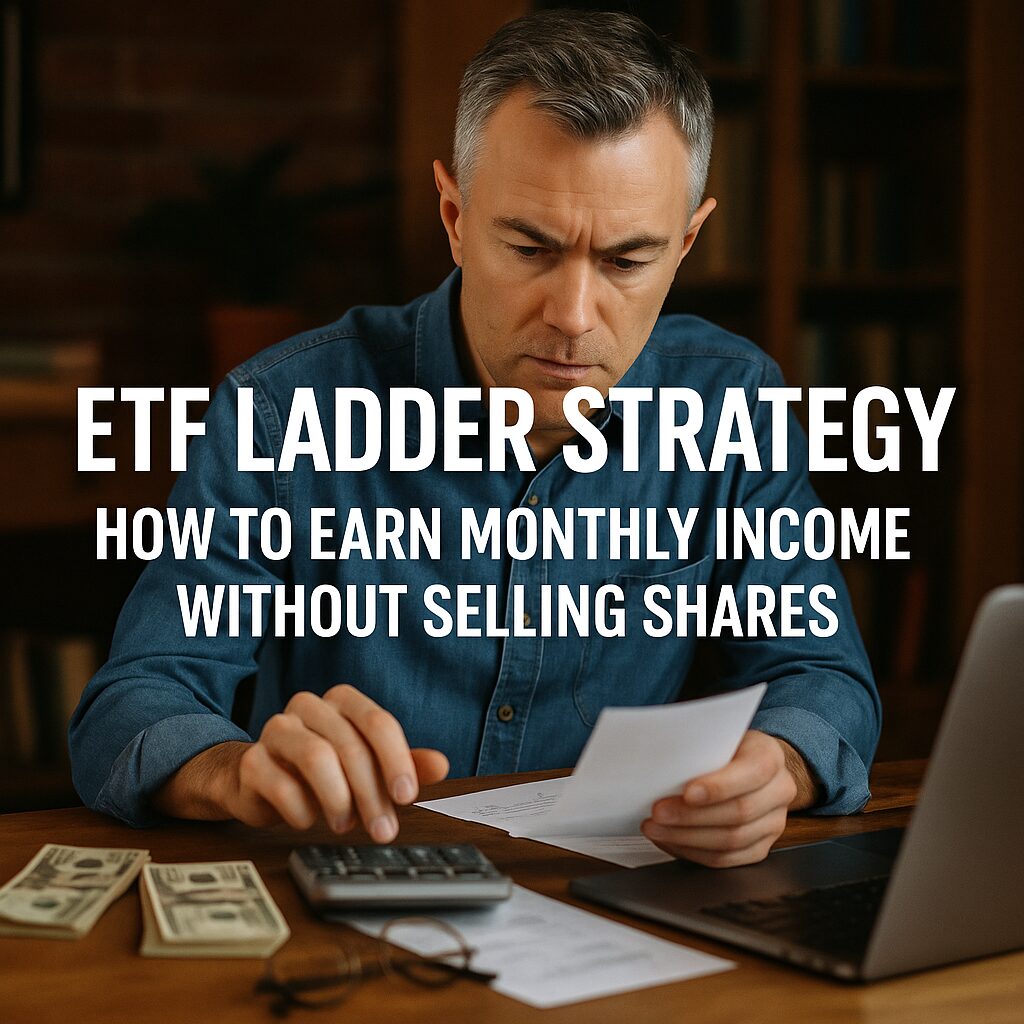Introduction
Generating a reliable stream of income without selling your investments sounds like a dream, but it’s possible with the ETF ladder strategy. Whether you’re aiming for financial independence, planning for retirement, or simply looking to supplement your income, ETF ladders offer a smart, tax-efficient, and low-maintenance solution. In this guide, we’ll break down exactly how to build and manage an ETF ladder, what ETFs to include, and how to turn it into a monthly income machine in 2025.
What is an ETF Ladder Strategy?
An ETF ladder strategy involves investing in a series of exchange-traded funds (ETFs) that pay dividends at different times of the year. By strategically choosing ETFs that distribute on staggered months—say January, February, and March—you can ensure that some income arrives every month without needing to sell any shares.
Think of it as a bond ladder—but with ETFs that can provide better liquidity, flexibility, and in many cases, superior yields.
Why Use an ETF Ladder Instead of Just One Monthly ETF?
- Diversification: Relying on one fund may expose you to risks tied to a specific sector or management style.
- Higher Yield Options: By choosing top-performing quarterly dividend ETFs with high yields, you can often beat the payout of a single monthly fund.
- Staggered Cash Flow: It reduces dependency on a single payout schedule and smoothens income.
Step-by-Step: How to Build Your ETF Ladder
Step 1: Choose 3–4 High-Yield Dividend ETFs
You’ll want ETFs that pay dividends quarterly—but on different months. Example:
- JEPI (JPMorgan Equity Premium Income) – Pays in January, April, July, October
- SCHD (Schwab U.S. Dividend Equity) – Pays in March, June, September, December
- VYM (Vanguard High Dividend Yield) – Pays in March, June, September, December
- DIVO (Amplify CWP Enhanced Dividend Income) – Pays monthly (optional for smoothing)
Step 2: Allocate Evenly
Start by dividing your capital evenly across your selected ETFs. For example, with $12,000:
- $3,000 in JEPI
- $3,000 in SCHD
- $3,000 in VYM
- $3,000 in DIVO (optional buffer)
Step 3: Track Dividend Calendar
Use a dividend calendar to confirm payment dates. Adjust holdings if multiple ETFs pay in the same month.
Step 4: Reinvest or Spend
- Reinvest to compound your income stream.
- Withdraw monthly payments for passive income.
Example: ETF Ladder Producing $500/Month
Let’s say your goal is $6,000/year in dividend income (~$500/month).
If your blended yield across ETFs is 6%:
- You’d need ~$100,000 invested.
Divided across the 4 ETFs:
- $25,000 in each ETF
Each ETF contributes $1,500/year in dividends, paid quarterly. But because payment months are staggered, you receive ~$500/month.
Tax Efficiency
- Most ETFs are qualified dividends, taxed at a lower rate.
- Holding ETFs in a tax-advantaged account (e.g., Roth IRA or ISA in UK) increases tax efficiency.
- Avoid selling shares and incurring capital gains tax.
Best Practices for 2025
- Stick to U.S. large-cap ETFs for reliability.
- Check the yield consistency – not just current yield.
- Avoid ETFs with high churn or active turnover – leads to inefficiencies.
- Review annually – rebalance your ladder if yields or payout schedules shift.
Tools You Can Use
- TrackYourDividends.com – For real-time income tracking
- ETF.com or Morningstar – Research fund performance & distribution history
- Google Sheets – Build a personalized dividend ladder calendar
Final Thoughts
An ETF ladder strategy gives you the best of both worlds: consistent income and capital preservation. By selecting the right ETFs and diversifying your payouts across months, you can enjoy monthly income without touching your principal. As the cost of living continues to rise, building a system that pays you every month becomes more essential than ever.
Start now, and by the end of 2025, your ETF ladder could be paying your bills while you sleep.
Next Steps:
- In the following article, we’ll compare this strategy to real estate investing: ETF vs Real Estate in 2025 – which one builds wealth faster?

